Tropical Fish Species
There are thousands of pet fish species that are common in the aquarium trade, so this list will be ever-growing. The information here is from credible sources, written by aquarium fish hobbyists and long time aquarium keepers. New tropical fish species information will be included here, from freshwater fish, to cichlids, bottom feeders, brackish fish, invertebrates and more.
Reference this useful aquarium fish descriptions list with the facts that you need to have a successful tropical fish aquarium.
If you are looking for information on Koi fish, the most popular pond fish or Gold Fish, we have created a page entirely devoted to these unique tropical fishes.
Also see our page on the ever popular first timer's fish, the siamese fighting fish also called the Betta fish and the large Oscar fish.
Zebra Danios
 Zebra Danios are surface dwellers and a peaceful schooling fish. Zebra fish are very active, lively and hardy. An excellent addition to any tropical aquarium because they are never shy, always visible and they feature a beautiful shimmering silver color that gives life to the aquarium. Zebra Danios are one of the best freshwater fish for starting out an aquarium. Zebra Danios are best kept in schools of 4 or more. When kept alone, they tend to be shy and nervous and get easily stressed out. Zebra Danios will school with other types of danios (leopard danios and spotted danios for example).
Zebra Danios are surface dwellers and a peaceful schooling fish. Zebra fish are very active, lively and hardy. An excellent addition to any tropical aquarium because they are never shy, always visible and they feature a beautiful shimmering silver color that gives life to the aquarium. Zebra Danios are one of the best freshwater fish for starting out an aquarium. Zebra Danios are best kept in schools of 4 or more. When kept alone, they tend to be shy and nervous and get easily stressed out. Zebra Danios will school with other types of danios (leopard danios and spotted danios for example). Maximum size: 2 inches - Average size: 1 inch
Sex differences: Females have more of a vivid silver tone then males and they grow larger and more round then the male zebra danio.
Clown Loach
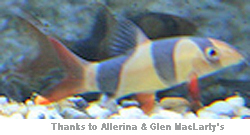 Clown Loaches are suitable for freshwater aquariums 20 gallons and up. They can get quite large but they grow very slow, so they can be put in a small aquarium as long as they are eventually upgraded to a larger tank. Clown Loaches are often added as a bottom feeder to aquariums to control snails, they eat pest snails and bottom food like shrimp pellets. Clown Loaches like adequate hiding spaces yet they still need open space to swim since they can be active at times and very shy at other times. They can be put together in schools but they are solitary once they get older. The Clown Loach is a great community fish addition for any tropical aquarium.
Clown Loaches are suitable for freshwater aquariums 20 gallons and up. They can get quite large but they grow very slow, so they can be put in a small aquarium as long as they are eventually upgraded to a larger tank. Clown Loaches are often added as a bottom feeder to aquariums to control snails, they eat pest snails and bottom food like shrimp pellets. Clown Loaches like adequate hiding spaces yet they still need open space to swim since they can be active at times and very shy at other times. They can be put together in schools but they are solitary once they get older. The Clown Loach is a great community fish addition for any tropical aquarium.Maximum size: 12 inches - Average size: 6 inches
Sex differences: Clown Loach females and males are indistinguishable from each other.
Tiger Barbs
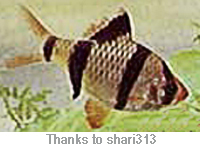 Tiger Barbs are schooling tropical fish that are quite active and an enjoyment to watch. Tiger Barbs are mildly territorial if they are not a part of a school. Minimum 3 per tank and they can be kept with other peaceful fish. Do not keep Tiger Barbs with slow moving, long finned tropical fish because they are fin-nippers and can be aggressive towards slow moving fish. Tiger Barbs are a hardy fish that will occupy all areas of a tank, top, middle and bottom. If your aquarium is small, 20 gallons and under, you might not want to include barbs because of their territorial nature unless you include other semi-aggressive fish then every fish school will establish their own territories. Tiger barbs are very hardy fish and a good addition to the semi-aggressive and fast-moving tropical fish aquarium.
Tiger Barbs are schooling tropical fish that are quite active and an enjoyment to watch. Tiger Barbs are mildly territorial if they are not a part of a school. Minimum 3 per tank and they can be kept with other peaceful fish. Do not keep Tiger Barbs with slow moving, long finned tropical fish because they are fin-nippers and can be aggressive towards slow moving fish. Tiger Barbs are a hardy fish that will occupy all areas of a tank, top, middle and bottom. If your aquarium is small, 20 gallons and under, you might not want to include barbs because of their territorial nature unless you include other semi-aggressive fish then every fish school will establish their own territories. Tiger barbs are very hardy fish and a good addition to the semi-aggressive and fast-moving tropical fish aquarium. Maximum size: 2.25 inches - Average size: 1 inch
Sex differences: Female Tiger Barb is more round and has lighter/pale color then males. The slimmer males have vivid coloring compared to females.
Cherry Barbs
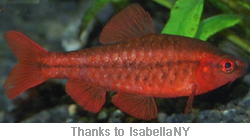 Cherry barbs are a shy fish, so adequate hiding spaces are necessary. Cherry barbs are a peaceful (when in schools) and hardy tropical fish that are a good addition to a tropical aquarium. Sometimes males can be a little bit aggressive but they tend to be more calm when they are in a school. It is recommended cherry barbs be in a school of at least 4 so that they keep to themselves and do not pick on other fish, unless you can distinguish and acquire only females, then a pair will be fine in any freshwater fish tank. Cherry barbs are very shy and nervous when kept alone.
Cherry barbs are a shy fish, so adequate hiding spaces are necessary. Cherry barbs are a peaceful (when in schools) and hardy tropical fish that are a good addition to a tropical aquarium. Sometimes males can be a little bit aggressive but they tend to be more calm when they are in a school. It is recommended cherry barbs be in a school of at least 4 so that they keep to themselves and do not pick on other fish, unless you can distinguish and acquire only females, then a pair will be fine in any freshwater fish tank. Cherry barbs are very shy and nervous when kept alone. Maximum size: 2 inches -Average size: 1 inch
Sex differences: Females are darker colored with yellow toned fins compared to the male Cherry barb.
Red Tailed Black Shark
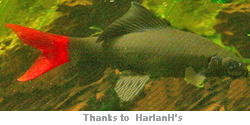 The Red Tailed Black Shark is a peaceful schooling fish when young, but beware they grow up to be solitary and highly aggressive towards their own species. They have been known to kill other Red Tailed Black Sharks that they once schooled with in an aquarium once matured. It is best to get only one per aquarium. These freshwater sharks are bottom dwellers that are very peaceful with other freshwater fish. Provide adequate hiding space for they need their privacy and can sometimes be shy. Other times, you'll find them swimming about in a frenzy with your other fish
The Red Tailed Black Shark is a peaceful schooling fish when young, but beware they grow up to be solitary and highly aggressive towards their own species. They have been known to kill other Red Tailed Black Sharks that they once schooled with in an aquarium once matured. It is best to get only one per aquarium. These freshwater sharks are bottom dwellers that are very peaceful with other freshwater fish. Provide adequate hiding space for they need their privacy and can sometimes be shy. Other times, you'll find them swimming about in a frenzy with your other fishMaximum size: 4.5 inches - Average size: 2.5 inches
Sex differences: Females are more bulky and more rounded then the slim and sleek male Red Tailed Black Shark.
Glass Catfish
 These unique fish are schooling fish that need at least three of their own species in a school. These catfish are shy and unsure, especially prone to disease if stressed so good water quality is required for optimal health. They live near the surface but need tall plants that reach the surface to hide in and provide cover. Floating plants, either live or fake are required for glass catfish. Glass catfish are good peaceful community aquarium fish but to do not keep with aggressive or overly territorial fish because they are easily stressed. These fish are good for the established community freshwater aquarium and a very interesting showcase fish.
These unique fish are schooling fish that need at least three of their own species in a school. These catfish are shy and unsure, especially prone to disease if stressed so good water quality is required for optimal health. They live near the surface but need tall plants that reach the surface to hide in and provide cover. Floating plants, either live or fake are required for glass catfish. Glass catfish are good peaceful community aquarium fish but to do not keep with aggressive or overly territorial fish because they are easily stressed. These fish are good for the established community freshwater aquarium and a very interesting showcase fish. Maximum size: 3.5 inches - Average size: 2.5 inch
Sex differences: The difference between the female and male glass catfish is indistinguishable.
Serpae Tetra
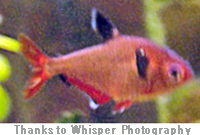 Serpae tetras are a peaceful and active schooling fish that will school with other species of tetra and continuously occupy every area of the tank. An excellent and hardy addition to any freshwater aquarium. Serpae Tetras do best when kept in a school of at least three, they tend to be shy when kept alone. An excellent community fish and can be kept with semi-aggressive species as long as they are in a school with other tetras, either other Serpae tetras or other similar tetra fish species.
Serpae tetras are a peaceful and active schooling fish that will school with other species of tetra and continuously occupy every area of the tank. An excellent and hardy addition to any freshwater aquarium. Serpae Tetras do best when kept in a school of at least three, they tend to be shy when kept alone. An excellent community fish and can be kept with semi-aggressive species as long as they are in a school with other tetras, either other Serpae tetras or other similar tetra fish species.Maximum size: 2 inches - Average size: 1 inch
Sex differences: Males are brighter red then the female Serpae Tetra.